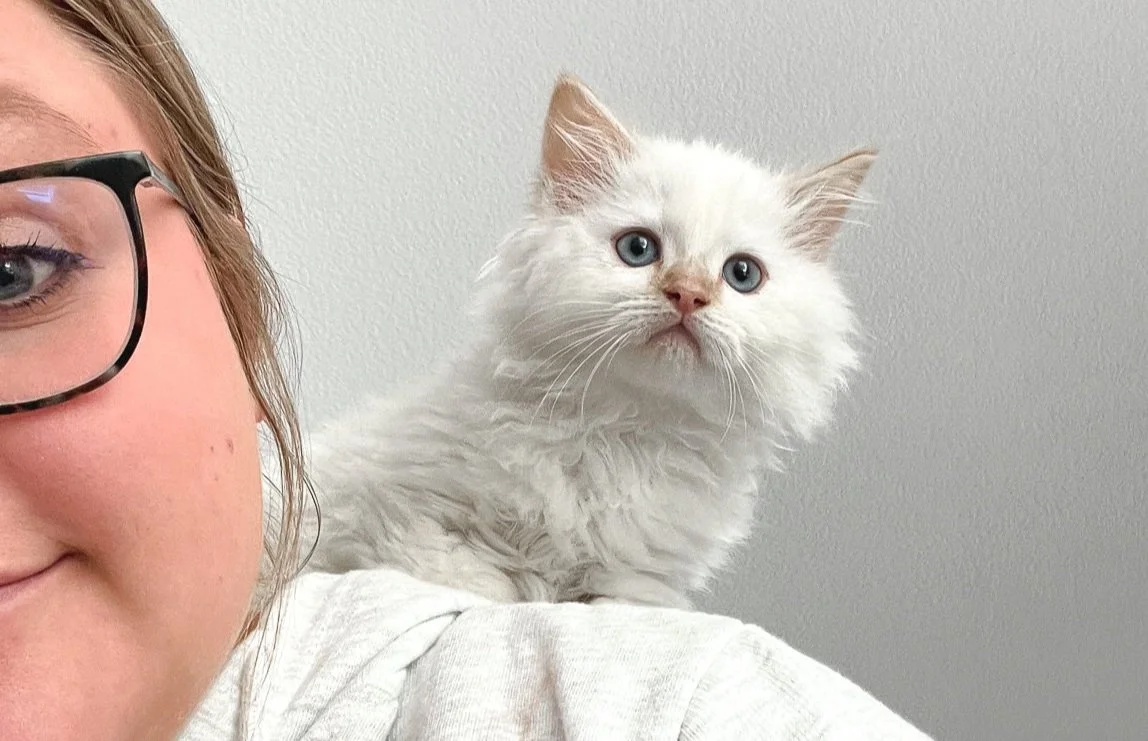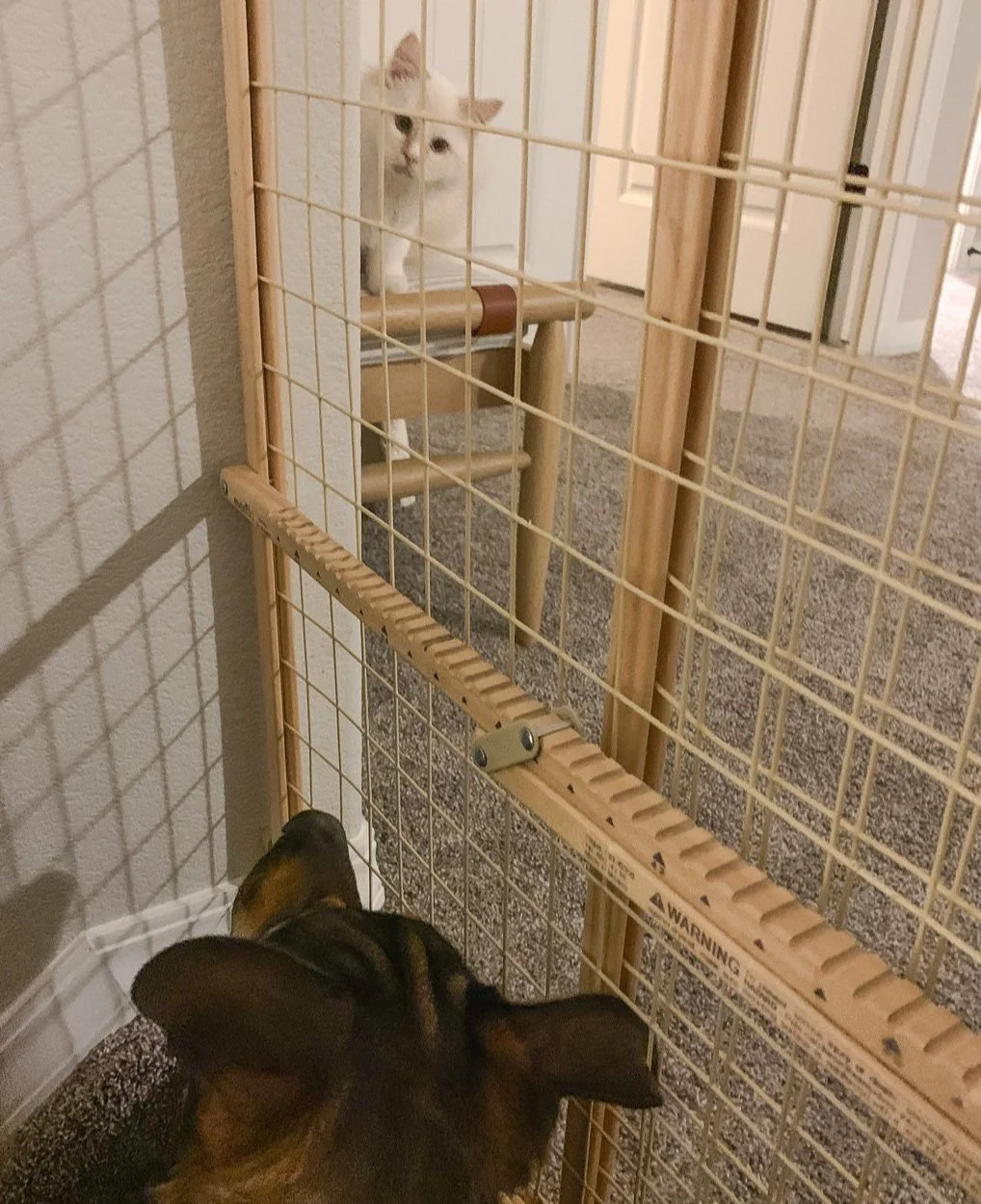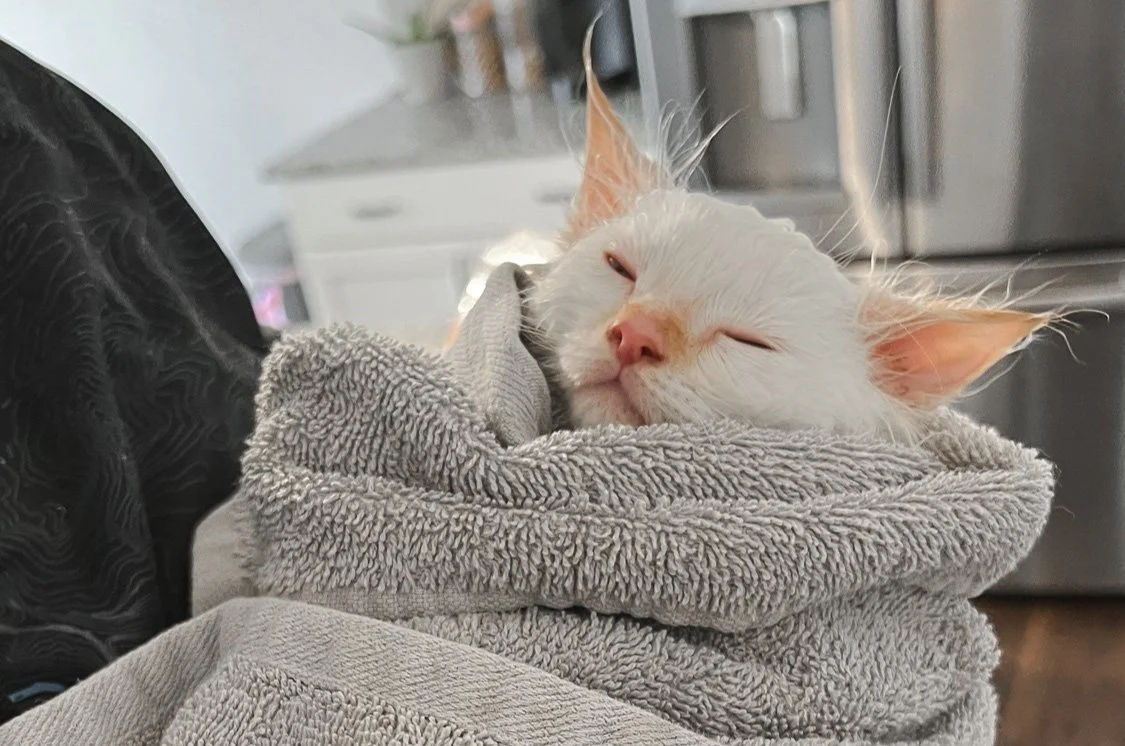Caring for Your New Ragdoll Kitten
Sweet Theodore loved to perch on my shoulder when he was little.
It’s exciting to bring home a sweet little, Ragdoll kitten! It’s also a big responsibility. Do you have all the supplies you will need? Have you kitten-proofed your home? How will you introduce your kitten to the other members of your family, both people and pets? There is a lot to consider. Here are some guidelines to help you make your adoption experience a bit more seamless.
Preparing for Your Kitten’s Arrival | Welcoming Your Kitten Home | Diet | Grooming | Veterinary Care
Preparing for Your Kitten’s Arrival
Kitten Essentials
Before your kitten arrives to your home, it’s important to have a stock of essential supplies such as food and water dishes (and of course food), a prepared litter box, scratching surfaces, toys, and a pet carrier. I suggest using a shallow dish or plate for food as cats don’t like their whiskers to touch the dish. Stainless steel or ceramic dishes are preferred as plastic dishes can harbor more bacteria and lead to acne around a cat’s chin. As for water, cats often prefer to drink running water as opposed to stagnant. I highly encourage you to purchase a fountain to ensure your kitten stays hydrated.
Just as important is a litter box. Be sure to place the litter box a distance away from the kitten’s food and water. An open or cubby-style box is best as many kittens are afraid of the style with a flap and may resort to using the floor. I send kittens home litter-box trained using Scoop Away Clumping Litter. I recommend having some of this on hand for an easy transition.
Ragdolls are a smart breed, and they enjoy enrichment activities. Placing scratchers around your home, especially near any furniture that might otherwise appeal to your kitten, can help prevent unwanted scratching. Keep in mind that Ragdolls grow to be an exceptionally large breed, so choose scratchers that will accommodate their size. Having plenty of toys around the house can also dissuade your kitten from getting into mischief. Springs, balls, feathers, bells, you name it!
For more inspiration, you can read about the products we love here: Products We Love for Our Ragdolls.
Kitten-Proofing Your Home
Just as with babies, it’s important to create an environment that will be safe for your kitten to explore. You may use this checklist to help:
✔ Eliminate toxic plants: Many common house plants and cut flowers are toxic to cats—lilies, eucalyptus, aloe, jade, and pothos being some of the most common. Review the ASPCA’s Poisonous Plants article for more information.
✔ Secure hazardous substances: Other hazardous substances such as cleaning products, beauty products, medication, etc. should be stored in a secure location.
✔ Secure sharp and breakable objects: Sharp objects should be stored out of reach of your Ragdoll kitten. A swallowed blade or needle could be fatal. Fragile or breakable objects should never be left too close to the edges of shelves, tables, or counters.
✔ Secure loose cords: Ragdoll kittens love to play with cords—power cords, blinds’ cords etc. To prevent electrocution and wire damage, secure power cords out of your kitten’s reach. You can also purchase cord covers or secure wires to the wall. Tie up blinds’ cords so kittens don’t accidentally get tangled or, worse, strangled.
✔ Keep food put away: Many human foods are harmful for your Ragdoll, including onions, garlic, raw eggs or meat, chocolate, grapes or raisins, and dairy. Be sure to keep food covered or put away, and don’t share your table scraps unless you know the food is safe!
✔ Keep toilet and garbage lids closed: Get in the habit of leaving the toilet lid down. You don’t want your Ragdoll kitten drinking from the toilet, or worse--falling in! Also be sure to secure your garbage cans. To a kitten, many types of garbage may seem like playthings, but strings and plastic bags, for example, can be dangerous if your kitten swallows them.
✔ Check for escape routes and hiding places: Check all doors and windows to make sure your Ragdoll will not be able to escape your home, especially if you like to leave doors or windows open. You should also familiarize yourself with places in your home your Ragdoll might be able to hide (underneath or behind furniture, inside the dryer or laundry basket, etc.) and ensure these locations are safe.
Theodore and Marie all cuddled up in their “safe zone” their first day home.
Welcoming Your Kitten Home
You will want to be sure you have a pet carrier to transport your kitten safely, especially if you are traveling a long distance. You may also consider some accessible water and a portable litter box for those particularly long journeys!
Upon your arrival, introduce your kitten to a “safe zone” you have already set up for him or her. This should be a small area with food, water, and a litter box. A small bathroom, closet, or laundry room would work well, though you want to make sure there aren’t too many places for your new kitten to hide. A calm environment will help ease the stress of traveling and help your kitten feel safe in their new environment.
Give your kitten time to explore this space, eat, drink, and use the litter box. Once your kitten begins to feel more secure, you can allow him or her to venture into other spaces of your home. You should return to the safe zone frequently so your kitten can begin to remember its location and find it independently.
Barty Boy and Hazel meeting each other safely through a gate.
Introducing Your Kitten to Other Pets
If you have other pets, you should introduce your new kitten slowly. It’s also best to wait until your new kitten has been checked out by a veterinarian to ensure the safety of all your pets. It’s easy for young kittens to develop mild upper respiratory illness with the stress of moving to their new homes. Keeping your new kitten separated by a door can also be helpful to allow your pets to warm up to each other without feeling overwhelmed. This method allows your pets to hear and smell each other without seeing each other quite yet.
Once you get the all-clear from your vet, you can remove the barrier of the door, but I recommend using a gate until you feel confident your pets will not harm each other. It can be helpful to allow them to see each other while still feeling safe and free to walk away. It may be a week or more before your pets are ready to meet face to face. This method has worked wonders for me as I have introduced new Ragdoll kittens to our family of German Shepherds and our skeptical pet cat, Marie.
Most of all, be patient as your new kitten gets settled into your home. Ragdolls are social and friendly by nature, but it’s important to allow your kitten to feel safe in his or her own time.
Diet
I send kittens home with Royal Canin Kitten dry food and Royal Canin Kitten Loaf in Sauce canned food. This food is high-quality, developed with the collaboration of scientific, veterinary, and behavioral experts. At 12 months of age, I recommend switching to Royal Canin Ragdoll Adult dry food and Royal Canin Digest Sensitive canned food.
Kittens are sensitive to change, so if you wish to feed a different kind of food, make the transition slowly over the course of a week or so. Start by mixing in a small amount of the new food and gradually mixing in more to give your Ragdoll kitten time to adjust. Sudden changes in diet can result in upset stomach, diarrhea, and/or constipation.
According to the Royal Canin experts, there are three common feeding methods for cats and kittens:
Self-service: This is the most natural style as most cats prefer to eat many small meals a day, as many as 16 in a 24 hour period. This is different from free-feeding in that you only put out the recommended daily amount, per your kitten’s food packaging and/or your veterinarian.
Meal feeding: This involves you feeding your kitten at set meal times. It’s best to divide the recommended daily ration over several smaller meals throughout the day.
Combination feeding: This method involves kibble on a self-serve basis and wet food at set meal times. If you use this approach, be sure to control the total amount of food provided to help your kitten maintain a healthy weight. (“A Guide to Kitten Feeding”)
In addition to food, it’s important your Ragdoll kitten always has access to clean drinking water. I generally recommend that you do not place the water directly next to your kitten’s food to avoid contamination. To encourage your kitten to drink plenty of water, it can be helpful to use a flowing fountain. A cat needs about 2 ounces of water per kilogram of body weight per day, more if they are especially active or exposed to warmer temperatures. If you are concerned your cat is not getting enough to drink, you may add a little unsalted meat stock to the water for flavor. Alternatively, you could add some fruit pieces such as cranberries or blueberries to make the drink more interesting. Providing some amount of wet food can also help your kitten stay hydrated.
Grooming
Start grooming your Ragdoll kitten for a few minutes each week. Your kitten’s coat won’t likely require as much grooming as an adult’s, but getting kittens used to a grooming routine will make things easier down the road.
Bartholomew enjoying being swaddled after his sink bath.
Bathing
It’s important to keep your Ragdoll kitten’s coat clean, but bathing too often can cause your kitten’s skin to become dry and irritated. When you do offer a bath, these tips can make the experience more enjoyable and keep your kitten’s skin and coat healthy:
Pre-fill the tub or sink with a few inches of luke-warm water and place a towel in the bottom so your kitten won’t slide around.
Get your kitten wet using a cup or small pitcher, taking care to avoid the face.
Use a kitten-safe shampoo and lather the kitten’s body.
You may use a damp washcloth to clean the kitten’s face.
Be sure to rinse your kitten’s coat thoroughly.
Towel dry your kitten as best you can, and keep your kitten warm as the coat continues to dry.
With care and patience, your Ragdoll may learn to love bath time! At the very least, it will be a tolerable experience.
Brushing
Unlike many long-haired breeds, Ragdoll cats do not have an undercoat. This makes some coats less likely to mat, though it does vary from cat to cat. Brushing once or twice a week will help keep your kitten’s coat healthy and tangle-free. It may also reduce hairballs as loose hairs are removed before they end up getting swallowed by your kitten. I find that a simple stainless steel-toothed comb works well to gently comb through your kitten’s fur. Pay close attention around your kitten’s neck, under the arms, and behind the legs, as these areas are the most prone to matting. If you do find a few mats you are unable to comb through, it’s important to clip them out to prevent them from spreading and pulling on your Ragdoll’s skin.
Nail Care
Please, please, never declaw your Ragdoll kitten! This is a painful and inhumane surgery that involves amputating the last joint of your kitten’s toes, and it can cause both health and behavioral issues down the road. Instead, provide plenty of scratching surfaces for your kitten and trim their nails regularly. To do this, approach your kitten when he or she is calm, and lightly massage your kitten’s paws. Once your kitten is comfortable, you can gently press each claw forward. Use cat nail trimmers to clip off the clear tip of the nail, taking care not to get too close to the quick. Offer lots of snuggles and treats to make this a pleasant experience for your kitten.
Veterinary Care
It’s important that your kitten receives regular veterinary care, including yearly check-ups and vaccines. It is also important that you are familiar with the signs your kitten may be ill or injured. If you notice any of the following symptoms, it may be time to take your Ragdoll kitten to the vet.
Changes in appearance
Your Ragdoll’s physical appearance is one measure of their overall health. Signs that something may be awry with your kitten include a dulling of the coat, hair loss, reddening of the eyes/ears/nose, or discoloration of the gums. Dark, waxy ears and discharge of the eyes or nose can be indicators of infection. Take your kitten to the vet if you notice any of these symptoms.
Changes in behavior
Changes in appetite or litter box use are some of the first clues that your Ragdoll may not be feeling well. Vomiting, diarrhea, or loss of appetite are all good reasons to take your kitten to see a vet. Eliminating outside the litterbox can also signal trouble, though you may first want to troubleshoot your kitten’s litterbox preferences. Changing the litter more frequently or getting an additional litter box are good first steps.
Sneezing, coughing, or audible congestion are signs your kitten has a cold. If the symptoms worsen or persist, it’s time to take your kitten to the vet. Increased itchiness can suggest dry skin or allergy, infection, or parasites, and increased vocalization can indicate discomfort. Lethargy or sudden withdrawal can be signs of more serious illness, so please seek vet care for these symptoms immediately.
Injury
Swelling, limping, and sensitivity to touch can point to injury. If you notice any of these symptoms, or if you notice any serious visible wounds, please seek vet care immediately.
The swelling through poor Theodore’s nose and forehead was the first sign he needed to see a vet right away.
This guide is a good start to caring for your Ragdoll kitten, but by no means is it exhaustive. Please contact me or your veterinarian if you have further questions about the care of your Ragdoll kitten.
Resources
ASPCA. “Poisonous Plants.” ASPCA, 2023. Accessed 10 December 2023.
“A Guide to Kitten Feeding.” Royal Canin, 2023. Accessed 10 December 2023.
Herzog, Suzanne. Taking Care of a Ragdoll Cat. Expertengruppe Verlag, 2023.






